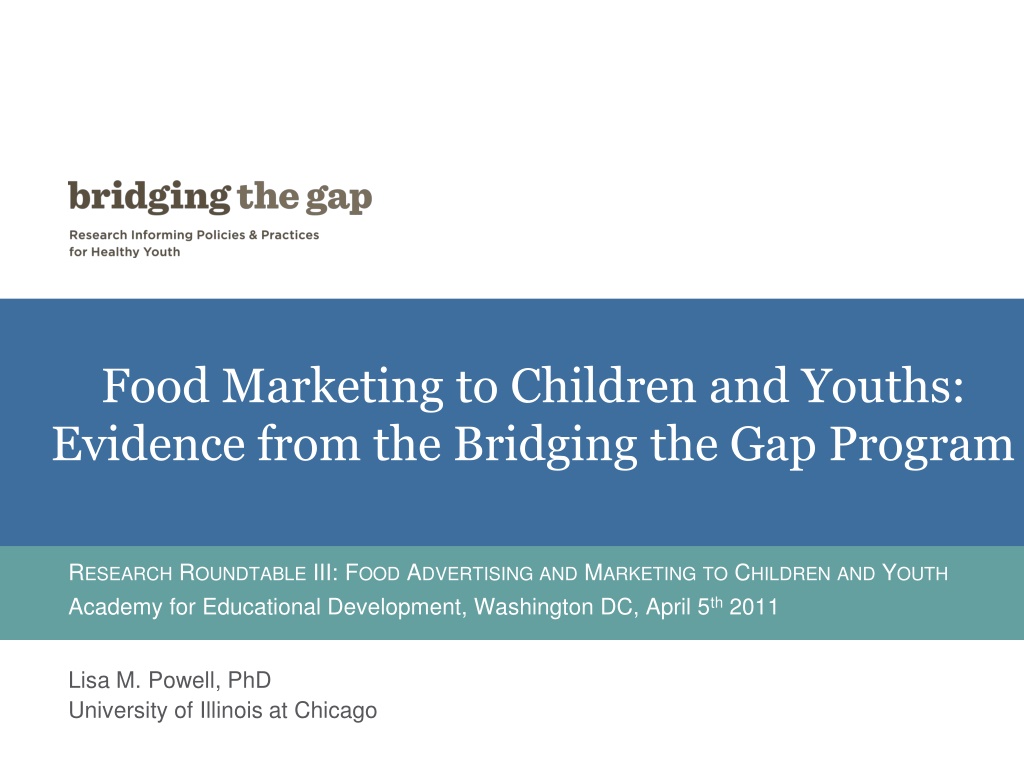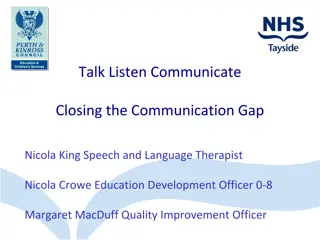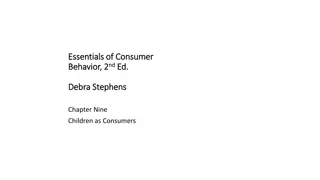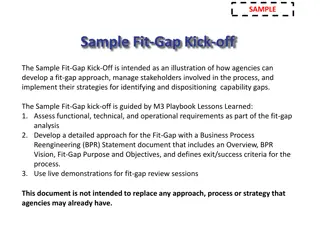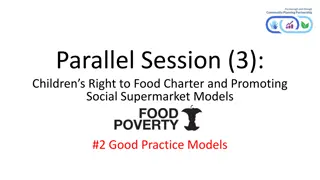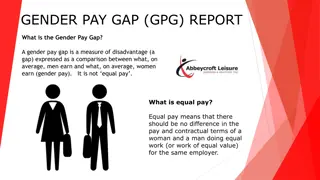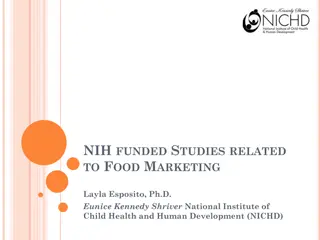Understanding Food Marketing to Children and Youths: Insights from Bridging the Gap Program
This research roundtable delves into the impact of food advertising and marketing on children and youths as part of the Bridging the Gap program. The collaborative effort assesses various health-related behaviors influenced by policies, programs, and environmental factors, including adolescent eating practices, physical activity, and weight outcomes. Led by experts like Lisa M. Powell and Frank Chaloupka, the initiative aims to address the prevalence of unhealthy foods and beverages in communities, marketing strategies targeting youth, and the importance of wellness policies in schools and organizations.
Download Presentation

Please find below an Image/Link to download the presentation.
The content on the website is provided AS IS for your information and personal use only. It may not be sold, licensed, or shared on other websites without obtaining consent from the author. Download presentation by click this link. If you encounter any issues during the download, it is possible that the publisher has removed the file from their server.
E N D
Presentation Transcript
Food Marketing to Children and Youths: Evidence from the Bridging the Gap Program RESEARCH ROUNDTABLE III: FOOD ADVERTISING AND MARKETING TO CHILDREN AND YOUTH Academy for Educational Development, Washington DC, April 5th2011 April 4-5, 2011 Lisa M. Powell, PhD University of Illinois at Chicago
Bridging the Gap is A collaborative effort to assess the impacts of policies, programs & other environmental factors on a variety of adolescent health-related behaviors An RWJF initiative begun in 1997 with focus on adolescent alcohol, tobacco, and other drug use and related outcomes More recently expanded to include youth eating practices, physical activity, and weight outcomes Linked to the ongoing, NIDA-funded, Monitoring the Future study www.bridgingthegapresearch.org 2
University of Michigan Lloyd Johnston, Project Director Institute for Social Research Monitoring the Future (MTF) Youth, Education and Society (YES!) University of Illinois at Chicago Frank Chaloupka, Project Director Health Policy Center ImpacTeen Food & Fitness www.bridgingthegapresearch.org 3
PI: Frank Chaloupka Co-Investigators and key staff include: Lisa Powell, Jamie Chriqui, Lindsey Turner, Dianne Barker, Leah Rimkus, Sandy Slater Sherry Emery, Glen Szczypka, Lisa Nicholson, Dan Taber, Roy Wada, Jidong Huang, Rebecca Schermbeck, Anna Sandoval, and others . www.bridgingthegapresearch.org 4
Bridging the Gap - Obesity State and National Annual collection of state policies and commercial data (UIC) Local and Community Planned annual community data collection and ongoing district wellness policy collection and coding (UIC) National food and beverage television advertising State level policies addressing the built environment Availability and accessibility of physical activity opportunities School and Organizational Local zoning codes, regulations, and ordinances that can impact on healthy eating and physical activity Annual YES (ISR-UM) and Food & Fitness surveys (UIC) Marketing of food/beverages at school Comprehensiveness of school district wellness policies Individual and Household State level policies and legislation around Safe Routes to School Presence and content of vending machines at school Market-level PSAs related to healthy eating, physical activity, and obesity Annual MTF surveys (ISR-UM) Commercial data (UIC) Availability of various foods/beverages in the school environment Self-reported height and weight, physical activity, and measures of healthy eating Household food expenditures Information on healthy eating and physical activity opportunities from key informant interviews Marketing of healthy/unhealthy foods and beverages in communities Frequency and length of physical education and recess Awareness and implementation of Alliance for a Healthier Generation Guidelines Implementation of school district wellness policies State taxation of beverages, snack foods, and restaurant food State policies related to healthy eating and physical activity Availability and accessibility of healthy food and beverages in stores and restaurants Characteristics of the built environment that impact on physical activity State policies related to school district www.bridgingthegapresearch.org wellness policies 5
Bridging the Gap data include Monitoring the Future Surveys of adolescents Household food purchases (HomeScan) Surveys of primary and secondary school administrators School district wellness policies Community-level observations Community-level ordinances and regulations Market and national level television advertising exposure State-level policies and regulations Variety of archival data www.bridgingthegapresearch.org 6
Childrens Exposure to Food-related Advertising on TV Nielsen Media Research Ratings Data
Advertising Data Targeted Ratings Points (TRPs) data on exposure to ads seen on TV obtained from Nielsen Media Research Ratings cover all programming seen by children Ratings points measure the reach and frequency of advertising. For example, a commercial with 80 TRPs for 2-5 year olds per month is estimated to have been seen an average of one time by 80% of children 2-5 over the defined period Ratings by: Year: 2003, 2005, 2007, and 2009 Age Groups: 2-5y, 6-11y, and 12-17y Race: All children, separately by white and black. Study does not include separate ratings for Hispanic children nor does it cover Spanish Language TV Food-related advertising categorized as: Cereal, Sweets, Snacks, Beverages, Fast Food Restaurants, Full-service Restaurants, and Other www.bridgingthegapresearch.org 8
Number of Food-Related Ads Per Day, By Year and Age Food-Related Children Age 2-5 Children Age 6-11 Adolescents Ages 12-17 2003 13.3 13.6 13.1 2005 12.1 13.5 13.4 2007 11.5 13.1 13.6 2009 10.9 12.7 14.5 % Change 2003-2009 -17.9% -6.9% 10.4% Food & Bev Products Children Age 2-5 Children Age 6-11 Adolescents Ages 12-17 2003 10.1 10.1 8.8 2005 8.7 9.7 8.5 2007 7.9 8.9 8.2 2009 6.8 7.9 8.4 % Change 2003-2009 -32.5% -21.7% -4.4% Fast Food Children Age 2-5 Children Age 6-11 2003 3.2 3.5 2005 3.3 3.8 2007 3.6 4.2 2009 4.1 4.8 % Change 2003-2009 28.7% 35.4% Adolescents Ages 12-17 4.4 4.9 5.5 6.1 40.4% www.bridgingthegapresearch.org 9
Exposure to Food Advertisements per Day for Children by Year Children Ages 2-5 Years 3 Fast Food Restaurant Ads 2.5 2 Ads Per Day Cereal Ads 1.5 Sweets Ads 1 Beverage Ads Snack Ads 0.5 0 2003 2005 2007 2009 www.bridgingthegapresearch.org 10
Exposure to Food Advertisements per Day for Children by Year Children Ages 6-11 Years 4 3.5 Fast Food Restaurant Ads 3 2.5 Axis Title Cereal Ads 2 1.5 Sweets Ads 1 Beverage Ads Snack Ads 0.5 0 2003 2005 2007 2009 www.bridgingthegapresearch.org 11
Exposure to Food Advertisements per Day for Adolescents by Year Adolescents Ages 12-17 Years 5 Fast Food Restaurant Ads 4.5 4 3.5 Ads Per Day 3 2.5 2 Sweets Ads 1.5 Beverage Ads Cereal Ads 1 Snack Ads 0.5 0 2003 2005 2007 2009 www.bridgingthegapresearch.org 12
Nutritional Content Analysis Food and beverage advertisements were assessed on the basis of: Saturated Fat (% Kcal): High >10% Kcal from saturated fat Sugar (%Kcal): High >25% Kcal from sugar Sodium (mg per 50g portion): High >200mg of sodium per 50g portion Fiber (g per 50g portion): Low <1.15g of fiber per 50g portion Nutritional Content was weighted by the ratings data to provide estimates of exposure to nutritional content www.bridgingthegapresearch.org 13
Food Ads High in Saturated Fat, Sugar or Sodium Children Ages 2-5 Years 100 80 60 Percent 40 20 0 All Foods Cereal Sweets 2003 Snacks Beverages Other 2009 www.bridgingthegapresearch.org 14
Food Ads High in Saturated Fat, Sugar or Sodium Children Ages 6-11 Years 100 80 60 Percent 40 20 0 All Foods Cereal Sweets 2003 Snacks Beverages Other 2009 www.bridgingthegapresearch.org 15
Food Ads High in Saturated Fat, Sugar or Sodium Adolescents Ages 12-17 Years 100 80 60 Percent 40 20 0 All Foods Cereal Sweets 2003 Snacks Beverages Other 2009 www.bridgingthegapresearch.org 16
Number of Ads Seen and Nutritional Content (%) of Ads for CFBAI vs. Non CFBAI Companies # of Ads per Day % of Ads High in SFSUSO 2003 2009 % Change 03-09 2003 2009 % Change 03-09 Age 2-5 CFBAI Companies Food and Beverage Products Subtotal Non CFBAI Companies Food and Beverage Products Subtotal CFBAI Fast Food Companies Subtotal Non CFBAI Fast Food Companies Subtotals 8.7 5.4 -37.5% 94.0% 88.2% -6.2% 1.4 1.4 -1.3% 93.3% 79.0% -15.3% 1.2 1.3 4.9% NA NA NA 1.1 1.5 38.8% NA NA NA Age 6-11 CFBAI Companies Food and Beverage Products Subtotal Non CFBAI Companies Food and Beverage Products Subtotal CFBAI Fast Food Companies Subtotal Non CFBAI Fast Food Companies Subtotals 8.6 6.4 -25.2% 93.6% 88.2% -5.8% 1.6 1.5 -2.2% 93.6% 79.4% -15.2% 1.2 1.5 27.9% NA NA NA 1.5 1.9 33.1% NA NA NA www.bridgingthegapresearch.org 17
Summary: Results of CFBAI Companies General Mills remains the largest advertiser; moderate reduction in ads seen by 2-5y (-16%) and an increase for 6-11y (6%). 97% of ads seen are for unhealthy products. Kellogg and Kraft ads are both down by about 40-50% for children, but about 9/10 ads still seen are for unhealthy products. Coke ads are down substantially (-57%), only company other than Cadbury with less than 50% of ads for unhealthy products. Pepsi ads down substantially (-70%), although 82% remain for unhealthy products. Overall, there were significantly fewer food and beverage product ads seen by children from CFBAI companies (-38%) compared to the 1% reduction in non- CFBAI food companies. But that the vast majority of the CFBAI company ads (88%) seen, in 2009, continued to be for products that were high in either saturated fat, sugar or sodium. www.bridgingthegapresearch.org 18
General Summary of Trends in Ad Content Positive reductions in exposure to food and beverage ads from 2003-09: -33%, -22% and -4% for 2-5y, 6-11y and 12-17y olds, respectively Cereal: -30% for 2-5y; -11% for 6-11y Sweets: -55% for 2-5y; -44% for 6-11y Snacks: -43% for 2-5y; -32% % for 6-11y Beverages: -43% for 2-5y; -41% for 6-11y But fast food ad exposure up substantially between 2003 and 2009: +21%, +31% and +37% for 2-5y, 6-11y and 12-17y olds, respectively The vast majority of ads seen in 2009 continue to be for products that are either high in saturated fat, sugar, or sodium: 86%, 87% and 81% of ads seen by 2-5y, 6-11y and 12-17y olds, respectively www.bridgingthegapresearch.org 19
Policy Implications of Trends in Ad Content Children, on average, continue to see more than 10 food-related ads on TV every day (teens see almost 15 ads per day) Children and teens continue to be exposed mainly to food and beverage ads for products that are high in saturated fat, sugar or sodium Study results suggest that industry self-regulation is limited in its effectiveness to substantially improve food-related advertising seen by children on TV Key issues of concern for policymakers regarding CFBAI self-regulation: No uniform nutritional standards No uniform definition of child audiences Does not address reach of ads in non-child programming Does not apply to children age 12 and over www.bridgingthegapresearch.org 20
Community Obesity Measures Project: Food Marketing Measures
Food Environment Measures Observational data collection o Food stores (supermarkets, grocery stores, convenience stores, gas stations, drug stores, dollar stores) o Fast food restaurants Measures and indices constructed o Availability, placement, pricing and quality of select food and beverage products and tobacco products o Food/beverage and tobacco advertising o Nutrition information www.bridgingthegapresearch.org 23
Physical Activity Environment Measures Observational data collection o Fitness centers (YMCA, B&G Clubs, JCCs, Commercial) o Community recreation centers and parks o PA Instructional schools (e.g., karate, dance) o Street segments Measures and indices constructed o Availability and quality of facilities; pricing o Safety, amenities, aesthetics o Walkability, bikability www.bridgingthegapresearch.org 24
Policy Environment Measures Local policy collection and coding: o Local ordinances and codes o Local zoning policies o Community master plans o Local taxes on soda and candy o School district wellness policies and joint use agreements o Menu labeling requirements o Restrictions on fast food, formula restaurants www.bridgingthegapresearch.org 25
BTG-Comp: Fast Food Observation Form 2011 www.bridgingthegapresearch.org 26
Preliminary Results: 2010 Data BTG-Comp: Fast Food Observation B. EXTERIOR MARKETING B1. % of Outlets with Advertisements on Building Exterior 72.7% B2.% of Outlets with Advertisements on Property 37.6% 26.0% COUNT THE NUMBER OF a. All Advertisements 1. Ads that include a Price Promotion 2. Ads that include a Food 3. Ads that include a Beverage a. Ads that include a Soda B3. Are there any ads with a ? a. Dollar menu promotion b. Health claim (grams of fat, # of calories) c. Cartoon character(s) d. TV or movie star or sports figure e. Kids meal toy f. Other child-targeted marketing 49.9% 31.3% 17.2% 9.0% 67.8% 41.0% 20.4% YES 9.0% 7.3% 5.3% 2.8% 5.6% 4.2% www.bridgingthegapresearch.org 27
BTG-Comp Food Store Observation Form 2011 www.bridgingthegapresearch.org 28
Preliminary Results: 2010 Data BTG-Comp Food Store Observation K. OUTDOOR ADVERTISING K1. % of Outlets with Advertisements on Building Exterior K2. % of Outlets with Advertisements on Property COUNT THE NUMBER OF b. All Food and/or Beverage Advertisements (IF 20+, CODE 20) 1. Ads that include a Price Promotion 2. Ads that include a Food a. Ads that include Fresh Produce (Salad, fruit, vegetables) 3. Ads that include a Beverage a. Ads that include Regular Soda a1. Ads that include Diet Soda b. Ads that include Regular Energy Drink 55.7% 30.2% 36.6% 23.5% 37.6% 13.2% 6.2% 1.8% 42.9% 21.3% 24.3% 17.3% New variable for 2011 Form 11.5% 4.4% www.bridgingthegapresearch.org 29
BTG-Comp: Street Advertising Grid 2011 www.bridgingthegapresearch.org 30
BTG-Comp: Street Advertising Grid 2011 E1. Content of Ad E2. Ad Placement E3. Ad Size Free-standing Billboard or larger Beverages a. Regular Soda a1. Diet Soda b. Regular Energy Drink c. Other Non-alcoholic d. Quick Service Restaurant Attached to a wall Smaller than a billboard <72 sq feet e. Food Store (w/food/bev) Attached to something else f. PA Product or Brand g. PA Service, Facility or Participatory Event Health of Anti-Tax Message h. Nutrition, Healthy Eating, Healthy Weight i. Exercise, Physical Activity j. Tobacco-free Lifestyle j1. Anti-tax Message (food/bev/tobacco) Screen Entertainment Cell Phone www.bridgingthegapresearch.org 31
Lisa Powell powelll@uic.edu ImpacTeen http://www.impacteen.org Bridging the Gap http://www.bridgingthegapresearch.org www.bridgingthegapresearch.org 32
